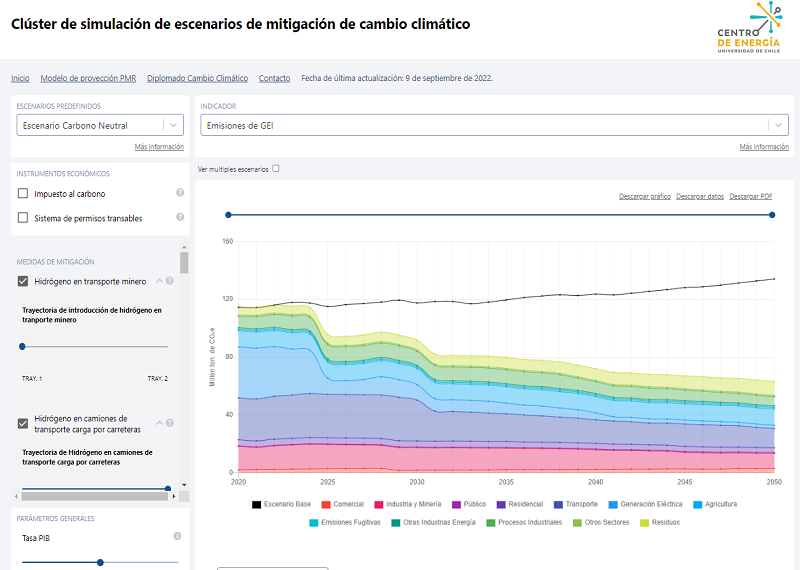
The PMR energy model developed by the Energy Center of the University of Chile is a simulation and analysis tool to evaluate the impact of different climate change mitigation scenarios. The computational tool allows evaluating the combined impact of different mitigation measures that contribute to meet the goal of carbon neutrality of emissions in Chile by 2050. Some examples of mitigation instruments and measures that can be modeled with this tool are described below:
- Tax on greenhouse gas emissions.
- System of Tradable Emission Permits.
- Emission Standard System proposed in the Climate Change Law.
- Emissions budget.
- Sectoral emissions limit.
- Electromobility in private vehicles, cabs and public transportation.
- Hydrogen in transportation and industrial processes.
- Electrification of heating systems.
- Retirement of coal and natural gas power plants.
- Introduction of storage systems.
- Energy efficiency.
- Non-motorized transport.
- Other measures
The main outputs of the model are:
- Projection of electricity generation supply by plant and type of technology.
- Projected energy demand for all sectors of the National Energy Balance.
- Projection of electricity demand.
- Projected installed capacity.
- Projected greenhouse gas (GHG) emissions.
- Projection of investment, operation and maintenance costs, for all sectors of the Energy Balance.
Some features of the model:
- Mathematical model based on optimization approach.
- Integrated supply and demand model. Energy supply and demand are projected in an integrated manner, considering the integration of both sectors.
- Projection of energy demand for the transportation, industry and mining, commercial, public and residential sectors.
- Projection of energy supply considering different sources and technologies: solar photovoltaic plants, CSP, wind, storage systems, hydroelectricity, geothermal, etc.
- Representation of short-term constraints of the electricity generation sector.
- Projection of all primary and secondary energy sources represented in the National Energy Balance: diesel, gasoline, kerosene, natural gas, liquefied gas, coal, electricity, hydrogen, etc.
- Emissions projection based on Greenhouse Gas Inventory methodologies.
Access the PMR Model through this link: https://modelopmr.cl/

The PMR energy model developed by the Energy Center of the University of Chile is a simulation and analysis tool to evaluate the impact of different climate change mitigation scenarios. The computational tool allows evaluating the combined impact of different mitigation measures that contribute to meet the goal of carbon neutrality of emissions in Chile by 2050. Some examples of mitigation instruments and measures that can be modeled with this tool are described below:
- Tax on greenhouse gas emissions.
- System of Tradable Emission Permits.
- Emission Standard System proposed in the Climate Change Law.
- Emissions budget.
- Sectoral emissions limit.
- Electromobility in private vehicles, cabs and public transportation.
- Hydrogen in transportation and industrial processes.
- Electrification of heating systems.
- Retirement of coal and natural gas power plants.
- Introduction of storage systems.
- Energy efficiency.
- Non-motorized transport.
- Other measures
The main outputs of the model are:
- Projection of electricity generation supply by plant and type of technology.
- Projected energy demand for all sectors of the National Energy Balance.
- Projection of electricity demand.
- Projected installed capacity.
- Projected greenhouse gas (GHG) emissions.
- Projection of investment, operation and maintenance costs, for all sectors of the Energy Balance.
Some features of the model:
- Mathematical model based on optimization approach.
- Integrated supply and demand model. Energy supply and demand are projected in an integrated manner, considering the integration of both sectors.
- Projection of energy demand for the transportation, industry and mining, commercial, public and residential sectors.
- Projection of energy supply considering different sources and technologies: solar photovoltaic plants, CSP, wind, storage systems, hydroelectricity, geothermal, etc.
- Representation of short-term constraints of the electricity generation sector.
- Projection of all primary and secondary energy sources represented in the National Energy Balance: diesel, gasoline, kerosene, natural gas, liquefied gas, coal, electricity, hydrogen, etc.
- Emissions projection based on Greenhouse Gas Inventory methodologies.
Access the PMR Model through this link: https://modelopmr.cl/
